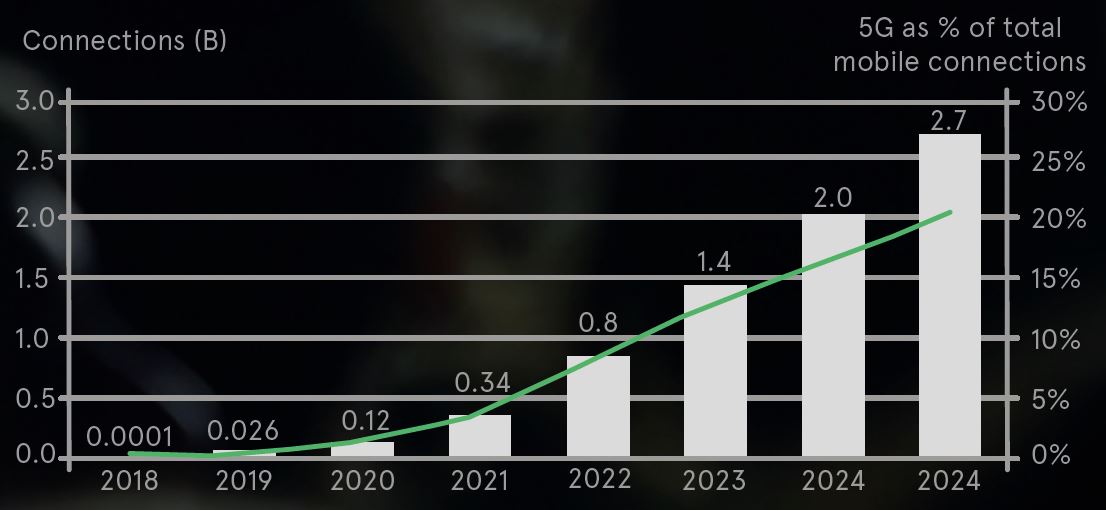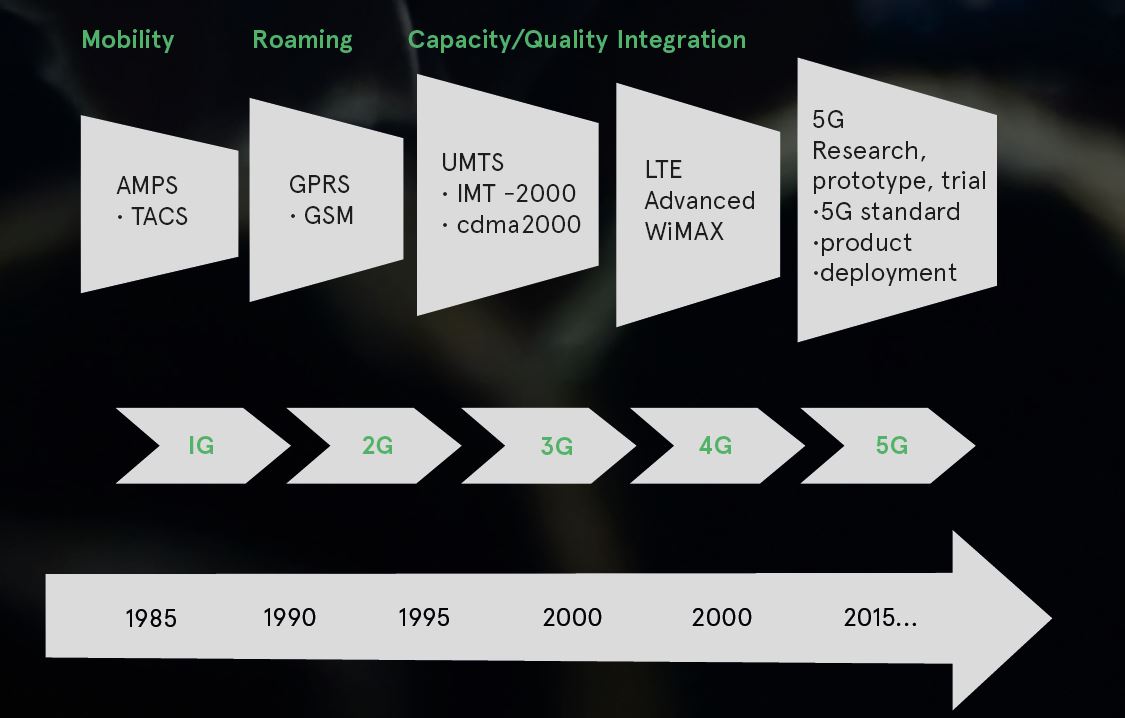The evolution of cellular networks
Follow Avnet Abacus on LinkedIn
Since the first 5G services were launched in the USA by Verizon and AT&T, 5G networks have been rolled out in a further 17 countries with South Korea, the United Kingdom, Germany, and the United States leading the charge and China catching up fast.
With analysts forecasting 2.7 billion 5G connections by 2025, (Figure 1), the uptake of 5G is expected to be faster than any previous cellular generation and expectations are running high for its future impact on the global economy.
In this review of the evolution of cellular networking, we take a brief look at previous generations of networks before examining why 5G is different and how it is expected to deliver the many anticipated economic benefits.

Figure 1: Forecast growth in global 5G connections (source: CCS Insight)
A trip through the generations
Since their initial arrival in the late 1970s, cellular networks and technology have evolved considerably, with successive generations, (2G through 4G) representing significant milestones in the development of mobile connectivity (Figure 2).
First Generation
Although not called 1G at the time, first generation mobile networks emerged in Japan in 1979, before rolling out to other countries such as the USA (1980), and the UK, (1985). Based on an analogue technology known as Advanced Mobile Phone System (AMPS), which used Frequency Division Multiple Access (FDMA) modulation, 1G networks offered a channel capacity of 30KHz and a speed of 2.4kbps. 1G networks only allowed voice calls to be made, suffered from reliability and signal interference issues and had limited protection against hackers.
Second Generation (2G)
Despite its flaws the 1G network wasn’t superseded until 1991, when 2G networks, were introduced. Based on digital signalling technology, Global System for Mobile Communication (GSM), which increased security and capacity, 2G networks offered bandwidths of 30KHz to 200KHz and allowed users to send SMS and MMS messages, although at low speeds, up to 64kbps. Continuous improvement of GSM technology led to the introduction of so-called 2.5G, which incorporated packet switching in the form of GPRS and also EDGE technology. 2.5G enabled data-rates up to 144kbps, enabling users to send and receive e-mail messages and browse the web.

Figure 2: Cellular network evolution timeline (source: https://www.researchgate.net/fi gure/Mobile-Cellular-Network-Evolution-Timeline_fi g1_263657708)
Third Generation (3G)
The arrival in the year 2000 of 3G, known as UMTS in Europe and CDMA2000 in the USA, heralded a change in the way mobile phones were used and viewed by the end user, becoming less about voice calls, more about social connectivity. Also based on GSM, the main aim of 3G was to support high-speed data and the original 3G technology allowed data-rates up to 14Mbps. With its ability to transmit greater amounts of data at higher speeds, 3G enabled users to make video calls, surf the web, share files, play online games and even watch TV online. Whereas 2G networks would enable a 3-minute MP3 song to be downloaded in around 6-9 minutes, the same file would take anywhere between 11 and 90 seconds to download on a 3G network. Today the most common use for 3G networks is as a backup for 4G.
Fourth Generation (4G)
The introduction of 4G really ushered in the era of the smartphone and hand-held mobile device. 4G is the first generation to use Long-Term Evolution (LTE) technology to deliver theoretical download speeds of between 10Mbps and 1Gbps, offering end users better latency (less buffering), improved voice quality, instant messaging services and social media, quality streaming and faster download speeds. 4G is also the first IP-based mobile network, handling voice as just another service and the technology is being developed to accommodate the Quality of Service (QoS) and rate requirements required by applications including wireless broadband access, Multimedia Messaging Service (MMS), video chat, mobile TV, HDTV content, Digital Video Broadcasting (DVB).
In the relatively short time since their introduction however, 4G networks are already struggling to cope with the demands placed upon them. Driven by emerging technologies such as Augmented Reality (AR), autonomous vehicles and the exponential growth of the Internet of Things (IoT), global
demand for mobile bandwidth is growing at an explosive rate. Technology giant Ericsson predicts a Compound Annual Growth Rate (CAGR) of 39 per cent in global mobile data traffic between now and 2023, equating to a total of 107 Exabytes (EB) per month. As well as being bandwidth hungry, emerging applications need higher speeds and lower latencies and the growing number of IoT devices is fuelling demand for ever higher numbers of connections – to over 29 billion by 2022, according to Ericsson.
Realising that 4G/LTE networks will ultimately reach capacity, the International Telecommunications Union, (ITU), in 2015, defined the requirements specification for 5G.
The 5G revolution
The ITU specification for 5G, contained in the document, ITU-R IMT-2020 (5G), is summarised in Figure 3. The ambitious specification represents a step-change in performance over 4G and aims to address the requirements of the emerging applications, described above. Throughputs up to 10Gbps (100 times faster than 4G networks) aim to satisfy the growing hunger for bandwidth; latencies of 1mSec (cf. 30 - 50mSec for 4G) will enable near-real time response rates; and connection densities of 1000 devices per square kilometre (100 times more than 4G) will support the growing numbers of IoT devices and sensors.

Figure 3: Selected key performance indicators of 5G according to ITU-R (source: “5G for Connected Industries and Automation”, 2nd edition, White Paper, 5GACIA, November 2018)
Having completed the 5G specification, the ITU delegated the definition of the 5G technical specifications to the global standards body, the 3rd Generation Partnership Project (3GPP). Founded in 1998, 3GPP is a global cooperation of independent standardisation committees (ARIB, ATIS, CCSA, ETSI, TSDSI, TTA, TTC), and has been responsible for the definition of technical specifications for wireless standards since the
introduction of 3G. 3GPP prioritises and groups specifications into releases, based on the sequence in which new functionality will be deployed in wireless networks. 5G specifications have been integrated into 3GPP releases 15 and 16 (Figure 4), with release 16 scheduled for completion in time for the ITU’s 2020 deadline. Completion of these specifications ensures that operators and manufacturers of 5G technology can have confidence in their designs and investments.

Figure 4: 3GPP release 15 and 16 schedule (Source: 3GPP)
Full deployment of all of the 5G capabilities defined in IMT-2020G requires implementation of totally new networks, significant investments by operators and considerable elapsed time to enable a full roll-out. To ease the migration path and enable operators to get to market early with 5G services, 3GPP defined 5G NR Non-Stand Alone (NSA), (NSA) technology in release 15 (Figure 5).

Figure 5: 5G NR non stand-alone (Source: Qualcomm)
5G NSA enables 5G services to be provided by leveraging existing LTE infrastructure. The throughput of existing macro cells can be increased by adding extra MIMO layers and operators can use existing spectrum in the so-called “MIMO sweet spot”, around 3.5GHz to offer a mainly consumer proposition, providing faster services to new 5G handsets.
Release 15 also includes the specifications for 5G NR Stand-Alone (SA) technology and release 16, scheduled for completion in early 2020, addresses the specifications for mmWave technology, based on spectrum allocation decisions due to be taken following the ITU’s World Radio Conference in October of 2019.
A review of 5G launch announcements (Table 1), confirms that the NSA route is popular with many operators around the world, with key exceptions being AT&T and Verizon who are using their mmWave licences to provide Fixed Wireless Access (FWA) services to consumers.
| OPERATOR |
FREQUENCIES |
SERVICES |
| AT&T |
39GHz |
Home Broadband |
| Verizon |
28/39GHz |
Home Broadband |
| T-Mobile (USA) |
600MHz |
Consumer, handsets, tablets, etc. |
| EE |
3.4GHz |
Consumer, handsets, tablets, etc. |
| Vodafone |
3.4GHz |
Consumer, handsets, tablets, etc. |
| China Unicom |
3.5GHz to 3.6GHz |
Consumer, handsets, tablets, etc. |
| South Korea (all 3 operators) |
3.5GHz |
Consumer, handsets, tablets, etc. |
Table 1: Summary of global 5G launch plans
5G is poised to change the way we live
It is only around 40 years since the birth of mobile telephony and in that time the capabilities of cellular networks have evolved at a pace which has fuelled both social change and innovation on a global scale. The capabilities of 3G then 4G networks were developed in response to demands for a mobile internet and have led to the smartphone and tablet becoming everyday accessories. However, the inexorable rise of the IoT and the demands of emerging applications such as AR/AI and self-driving cars have stretched the capabilities of 4G networks to their limits leading to the development of the next generation of cellular networking, 5G.
Whereas 3G and 4G networking were focused on voice and data services and are mainly associated with the smartphone, 5G offers much more, promising to enable the inter-connection of billions of devices of almost any kind. More than a faster wireless capability, 5G promises to transform existing consumer, business and industrial processes, unlocking new levels of productivity and innovation and driving the next wave of global economic growth. The 5G roll-out has only just begun but, with operators poised to invest in the infrastructure required to unlock the full power of 5G, the global economy stands on the verge of the next wave of growth.

Follow Avnet Abacus on LinkedIn
Want more like this? Register for our Newsletters
About Author
Martin Keenan
As Technical Director, Martin is responsible for technical marketing strategy across IP&E, power and...
abacus content library/articles/the-evolution-of-cellular-networks
The Evolution of Cellular Networks | Engineers' Insight | Avnet Abacus



